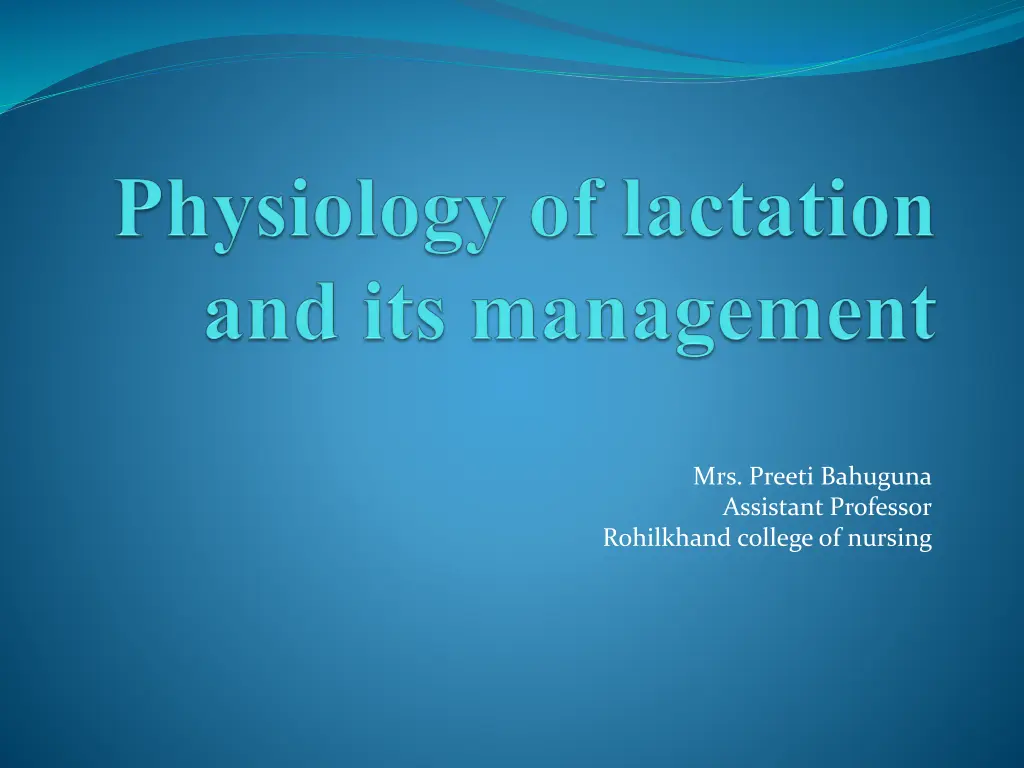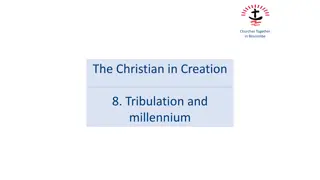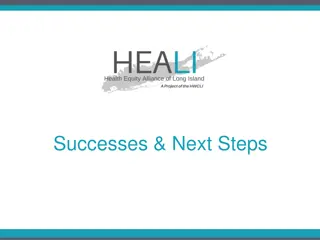
Essential Guide to Breastfeeding: Physiology, Composition, and Reflexes
Explore the intricate process of breastfeeding, from the interplay of hormones and learned behaviors to the composition of colostrum and breast milk. Learn about the stages of lactation and the maternal breastfeeding reflexes that support successful nursing. Dive into the physiology of lactation and milk production, understanding the vital role of prolactin and oxytocin.
Download Presentation

Please find below an Image/Link to download the presentation.
The content on the website is provided AS IS for your information and personal use only. It may not be sold, licensed, or shared on other websites without obtaining consent from the author. If you encounter any issues during the download, it is possible that the publisher has removed the file from their server.
You are allowed to download the files provided on this website for personal or commercial use, subject to the condition that they are used lawfully. All files are the property of their respective owners.
The content on the website is provided AS IS for your information and personal use only. It may not be sold, licensed, or shared on other websites without obtaining consent from the author.
E N D
Presentation Transcript
Mrs. Preeti Bahuguna Assistant Professor Rohilkhand college of nursing
INTRODUCTION Breastfeeding depends on the interplay of hormones, reflexes and learned behavior of the mother and newborn. Successful lactation is the end result of numerous interacting factors including the maturity and anatomy of the newborn , the health and nutrition of the mother, and the development of the mammary glands.
COLOSTRUM It is deep yellow serous fluid , alkaline in reaction. It has got a higher specific gravity; a high protein , vitamin A sodium and chloride content but has got lower carbohydrate fat and potassium than breast milk. It contain antibody (IgA) produced locally.
COMPOSITION Protein Fat CHO Water Colostrum 8.6 2.3 3.2 86 Breast milk 1.2 3.2 7.5 87
PHYSIOLOGY OF LACTATION Lactation starts following delivery under the control of numerous endocrine glands particularly the pituitary hormones prolactin and oxytocin. It is influenced by the suckling process and by maternal emotion.
STAGES OF LACTATION Mammogenesis Lactogenesis Galactokinesis Galactopoiesis
MATERNAL BREAST FEEDING REFLEXES PROLACTIN REFLEX:
NIPPLE ERECTION REFLEX Stimulation of the breast nipple by the infant s mouth leads to nipple erection. The stimulation makes the nipples more prominent . This assists in the propulsion of milk through the lactiferous sinuses to the nipple pores.
MILK PRODUCTION In the first postpartum week, the total amount of milk yield in 24 hours is calculated to be 60 multiplied by the number of postpartum days and is expressed in terms of milliliters. Thus the milk yield on the 4thday is about 60*4=240ml . A milk yield of 120-180 ml per feeding is usual by the end of second week.
STIMULATION OF LACTATION
DURING DELIVERY To improve the maternal instinct to nurse the baby mentioning the advantages of breastfeeding. Care and preparation of the nipples including teaching the patient as to how to express out the colostrums and to take care of the crust formed on the nipples.
Cont To put the baby to the breast immediately intervals for 3 minutes from the first day, If the condition permits /demand feeding. Plenty of fluids to drink. To avoid engorgement and trapping of milk, manual expression prior to the nursing is done.
LACTATION FAILURE It may be due to infrequent suckling or due to the endogeneous suppression of prolactin . Pain anxiety and insecurity May be the hidden reasons. Unrestricted feeding at short intervals (2-3 hours ) is helpful.
DRUGS TO IMPROVE MILK PRODUCTION Metaclopramide (10mg thrice daily ) increases milk volume by increasing prolactin levels. Sulpuride has also been found effective . Intranasal oxytocin contracts myoepithelial cells and causes milk let down.
LACTATION SUPRESSION This becomes necessary if the baby is born dead or dies in the neonatal period or when patient does not like to breastfeed her baby or if breastfeeding is contraindicated. This can be effective , either by using hormones or by mechanical means.
COMMON USED METHOD To stop breastfeeding To avoid pumping or milk expression To wear breast support Ice packs to prevent engorgement Analgesics to relieve pain A tight compression bandage is applied for 2-3 days.
DRUGS USED IN LACTATION SUPPRESSION Combination of testosterone and oestrogen preparation(mixogen)-2 ampoules intramuscularly . The risk of using oestrogenicpreparation in puerperium includes thromboembolic manifestation or late postpartum blood loss.
CULTURE ASPECT OF LACTATION To promote lactation and provide proper assistance to a new mother , nurses should consider cultural beliefs : In the Philippines if the mother s milk does not flow regularly , a meal of chicken and green papaya boiled in coconut milk is suggested. A phillippines mother may be adviced to eat a soup of boiled clams and ginger. Some phillippines mother use hot application of special medicinal preparartion to stimulate lactation.
CONT Korean mothers eat sea weeds soup with rice to increase milk production. Curner 1978 reported that Hispanic Americans believe that exposing mothers to cold diminishes the flow of milk. Filipinas ,Mexicans Americans and some Nigerians typically don t give colostrums to their infants . These mothers begin breastfeeding after their milk has come in. Some Korean women don t begin breastfeeding until 3 days after the birth , whereas others begins breast feeding immediately and offer the breast every time the infant cries.
MINOR DISCOMFORTS OF PUERPERIUM There are certain ailments which occurs during the puerperium:- 1. After pains 2. Pains in the perineum 3. Constipation 4. Fatigue 5. Post partum diuresis 6. Disturbed daily living activity
AFTER PAINS It is a spasmodic, colicky pain in the lower abdomen during the early postpartum days due to vigorous contraction of the uterus . It is more common & more severe in multiparous due to weak muscle tone.
CHARACTERISTICS After pain occurs during the first 2-3 days of Puerperium Abdominal pains (like cramps ) and back pain. Strong regular & Co-ordinate. The intensity frequency and regularity of contraction decrease after the 1stpostpartum day. More severe when breast-feeding in both primipara & multipara.
Predisposing Factors Presence of blood clot , piece of membranes or placental tissue. Breast-Feeding increases after pains.
CAUSES Uterine contraction Lactation Lochia discharge infection
MANAGEMENT Use relaxation & breathing technique used during labour. Start walking after soon after delivery. Keep your bladder empty. Frequent breastfeeding ,starting immediately after birth,can also alleviate after pains.
Massage the uterus & with expulsion of clot administer analgesic (ibuprofen) And antispasmodic. Encourage mother for warm and liquid diet. Encourage mother for vulval hygiene.
PAIN IN PERINEUM It is normal in the area between the vagina and anus (perineum) to feel sore and uncomfortable for a while after the birth. This area will have stretched a lot as baby s head entered. Some degree of pain is felt in the stitches ,abnormal pain should be investigated to diagnose vulvus vaginal hematoma or infection is developing.
MANAGEMENT Lie down ,so that pressure is taken off to the bottom. Put a cold gel pad or frozen pack of peas ,wrapped in a clean flannel on your perineum. Have a warm bath. Keep doing the pelvic floor exercise. Keep the wound clean and have a shower or bath daily.
Cont. Contact to the doctor if fever is there. Take analgesics prescribed by the doctor.
Care of perineal stitches Clean & dress the perineal area daily & cover with sterile pad. Advice the mother to use topical anesthetic spray or ointment .
CONSTIPATION The problem is much less because of early ambulation and liberalization of diary intake . At least 20% of the mothers constipated after giving birth, intake of prenatal medication may change bowel movement.
CAUSES Internal causes:- Numbness of area around the anus vagina and nerve inside . Intake of prenatal Vitamin. Anxiety High level of progesterone.
External causes:- The stitches and bruising of skin during delivery. Painkillers like pethidine or diamorphine.
MANAGEMENT Treatment through diet:- Drink plenty of water. Drink copious quantity of fruit juice. Drink a cup of warm water after waking up. High fibre diet. Avoid refined food.
Treatment through life style changes:- Don t ignore any bowel movement for the fear of pain. Increasing your activity by moving around a bit. Instead of sitting down straight after a meal , walk around a bit. Consult with your doctor.
Postpartum fatigue It is the physical and emotional exhaustion expect in the weeks following delivery. Every women experience postpartum fatigue.
CAUSES Rigors of labour and delivery. Too little sleep. Stress of caring newborn. Excessive blood loss.
MANAGEMENT Take rest, sleep when the baby sleeps. Ask your partner to help in daily living activities as well as in care of baby. If fatigue seems excessive check with your practitioner to make sure it does not have a hidden physiological cause. Advice mother to eat healthy diet, drink plenty of water because dehydration leads to more fatigue , take naps.
POST-PARTUM DIURESIS With in 12 hours of birth the women begins to loose excess fluid accumulated during pregnancy. The profuse diaphoresis occurs especially at night for the first 2-3 days after child birth.
Causes Decreased estrogen level Removal of increased venous pressure in the lower extremities. Loss of remaining pregnancy induced increase in blood volume.
MANAGEMENT Keep the mother clean and dry. Change the dress frequently. Changes the bed sheet frequently. Care must be taken to ensure that the mother is well hydrated.



